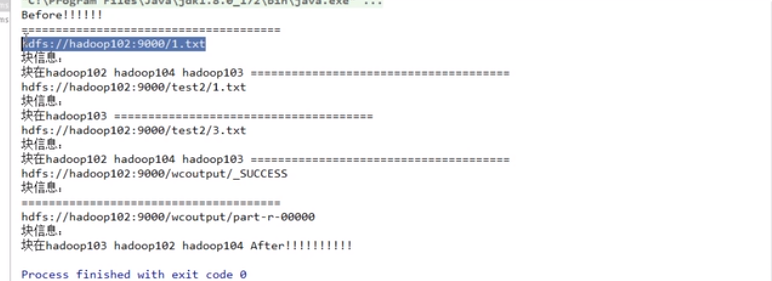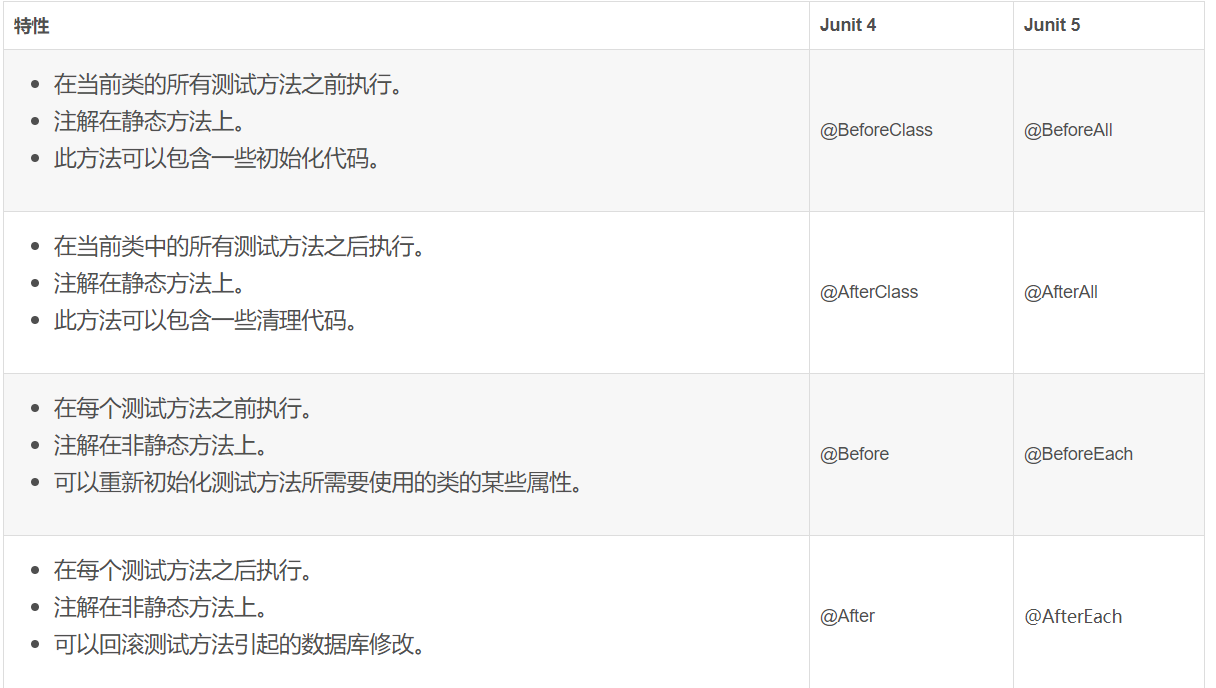1、首先配置好hadoop的环境变量等内容,配置好maven然后编写一个简单的程序(他的目的是将本地的一个文件进行上传)
代码如下:
package com.atguigu.hdfsclient;
import org.apache.hadoop.conf.Configuration;
import org.apache.hadoop.fs.FileSystem;
import org.apache.hadoop.fs.Path;
import org.junit.jupiter.api.Test;
import java.io.IOException;
import java.net.URI;
public class HDFSClient {
@Test
public void put() throws IOException, InterruptedException {
FileSystem fileSystem= FileSystem.get(URI.create("hdfs://hadooplinux01:9000"),new Configuration(),"root");
fileSystem.copyFromLocalFile(new Path("C:\Users\26301\Desktop\1.txt"),new Path("/"));
fileSystem.close();
}
}
运行结果如下:(可以看到已经运行成功了)


2、更加详细的代码操作如下(上传、下载、删除、修改、追加等等)
代码如下:
package com.atguigu.hdfsclient;
import org.apache.hadoop.conf.Configuration;
import org.apache.hadoop.fs.*;
import org.apache.hadoop.io.IOUtils;
import org.junit.jupiter.api.*;
import java.io.FileInputStream;
import java.io.IOException;
import java.net.URI;
import java.util.Map;
public class HDFSClient {
private FileSystem fs;
@BeforeEach
public void before() throws IOException, InterruptedException {
fs=FileSystem.get(URI.create("hdfs://hadooplinux01:9000"),new Configuration(),"root");
}
//进行文件的下载
@Test
public void get() throws IOException, InterruptedException {
//第一步是获取HDFS对象
//获取文件系统写入参数(url模式为hdfs)
Configuration configuration=new Configuration();//就好像和site.xml中的相关配置是一样的(这里使用默认的配置)
configuration.setInt("dfs.replication",1);
FileSystem fileSystem=FileSystem.get(URI.create("hdfs://hadooplinux01:9000"),configuration,"root");
//获得到了filesystem
/*下面是进行文件的下载操作
* */
fileSystem.copyToLocalFile(new Path("/1.txt"),new Path("D:\"));
//操作完成之后进行关闭,因为不支持并发访问
fileSystem.close();
}
//进行文件的上传
@Test
public void put() throws IOException, InterruptedException {
FileSystem fileSystem= FileSystem.get(URI.create("hdfs://hadooplinux01:9000"),new Configuration(),"root");
fileSystem.copyFromLocalFile(new Path("C:\Users\26301\Desktop\1.txt"),new Path("/"));
fileSystem.close();
}
//进行重命名
@Test
public void rename() throws IOException, InterruptedException {
//获取文件系统
FileSystem fileSystem= FileSystem.get(URI.create("hdfs://hadooplinux01:9000"),new Configuration(),"root");
//进行操作
fileSystem.copyFromLocalFile(new Path("/1.txt"),new Path("/2.txt"));
//关闭文件系统
fileSystem.close();
}
//进行删除操作
@Test
public void delete() throws IOException {
boolean delete=fs.delete(new Path("/1.txt"),true);
if (delete)
{
System.out.println("删除成功");
}
else
{
System.out.println("删除失败");
}
}
//进行内容的追加
@Test
public void append() throws IOException {
FSDataOutputStream append=fs.append(new Path("/1.txt"),1024);
FileInputStream open=new FileInputStream("D:\1.txt");
//进行流拷贝(依次完成读写操作)
IOUtils.copyBytes(open,append,1024,true);
}
//文件的查看
@Test
public void ls() throws IOException {
//与下面的区别是这个文件夹和问价一起查
FileStatus[] fileStatuses=fs.listStatus(new Path("/"));
for(FileStatus fileStatus : fileStatuses)
{
if (fileStatus.isFile())
{
System.out.println("一下信息是一个文件信息");
System.out.println(fileStatus.getPath());
System.out.println(fileStatus.getLen());
}
else
{
System.out.println("这是一个文件夹");
System.out.println(fileStatus.getPath());
}
}
}
@Test
private void listFiles() throws IOException {
//将所有的文件列出来,对于目录进行递归(与上边的区别是只查文件不查文件夹)
RemoteIterator<LocatedFileStatus> files=fs.listFiles(new Path("/"),true);
while(files.hasNext())
{
//获取块的信息,并且查看备份的文件都在哪里
LocatedFileStatus file=files.next();
System.out.println("------");
System.out.println(file.getPath());
System.out.println("快信息");
BlockLocation[] blockLocations=file.getBlockLocations();
for(BlockLocation blockLocation : blockLocations)
{
String[] hosts=blockLocation.getHosts();
}
}
}
@AfterEach
public void after() throws IOException {
fs.close();
}
}
部分运行结果:

3、零碎的知识点集合:
idea中的System.out.println()的快捷键是cout。buffersize表示的是缓冲区的大小
4、不同注释的区别:

5、HDFS的相关文件操作:
将文件上传到hdfs 1.首先创建一个文本文件 #touch 创建文件 mkdir 创建文件夹 touch test #编辑文件 vim test 2.可以随便输入一些内容 hello world hello lilei hello haimeimei hello hadoop 保存退出 3.将文件上传到hdfs根目录中 #将文件上传到Hadoop根目录中 hadoop fs -put test / #查看是否上传成功 hadoop fs -ls / #查看文件内容,发现与之前的内容相同则上传成功 #如果你在安装虚拟机的时候没有选择中文,而在文件中有中文内容,有可能造成乱码 hadoop fs -cat /test #hdfs上的文件是不支持修改的 如果想要上传到指定目录,直接替换根目录(/)即可 文件上传成功了,那么接下来试一试文件夹 #创建文件夹 mkdir testdir #上传 hadoop fs -put testdir / #查看 hadoop fs -ls / 删除文件/文件夹 #删除文件 hadoop fs -rm -f /test #删除文件夹 hadoop fs -rm -r /testdir #查看 hadoop fs -ls / 将hdfs上的文件下载到本地 #将文件上传上去 [root@master tmp]# hadoop fs -put test / #将test改名为test1 [root@master tmp]# hadoop fs -mv /test /test1 #查看文件内容 [root@master tmp]# hadoop fs -cat /test1 hello world hello lilei hello haimeimei hello hadoop #文件下载 [root@master tmp]# hadoop fs -get /test1 #查看tmp文件夹下的内容 [root@master tmp]# ls test test1 testdir
6、更多的文件操作如下:
3.2.1 HDFS文件上传(测试参数优先级)
1.编写源代码
|
@Test public void testCopyFromLocalFile() throws IOException, InterruptedException, URISyntaxException {
// 1 获取文件系统 Configuration configuration = new Configuration(); configuration.set("dfs.replication", "2"); FileSystem fs = FileSystem.get(new URI("hdfs://hadoop102:9000"), configuration, "atguigu");
// 2 上传文件 fs.copyFromLocalFile(new Path("e:/banzhang.txt"), new Path("/banzhang.txt"));
// 3 关闭资源 fs.close();
System.out.println("over"); } |
2.将hdfs-site.xml拷贝到项目的根目录下
|
<?xml version="1.0" encoding="UTF-8"?> <?xml-stylesheet type="text/xsl" href="configuration.xsl"?>
<configuration> <property> <name>dfs.replication</name> <value>1</value> </property> </configuration> |
3.参数优先级
参数优先级排序:(1)客户端代码中设置的值 >(2)ClassPath下的用户自定义配置文件 >(3)然后是服务器的默认配置
3.2.2 HDFS文件下载
@Test
public void testCopyToLocalFile() throws IOException, InterruptedException, URISyntaxException{
// 1 获取文件系统
Configuration configuration = new Configuration();
FileSystem fs = FileSystem.get(new URI("hdfs://hadoop102:9000"), configuration, "atguigu");
// 2 执行下载操作
// boolean delSrc 指是否将原文件删除
// Path src 指要下载的文件路径
// Path dst 指将文件下载到的路径
// boolean useRawLocalFileSystem 是否开启文件校验
fs.copyToLocalFile(false, new Path("/banzhang.txt"), new Path("e:/banhua.txt"), true);
// 3 关闭资源
fs.close();
}
3.2.3 HDFS文件夹删除
@Test
public void testDelete() throws IOException, InterruptedException, URISyntaxException{
// 1 获取文件系统
Configuration configuration = new Configuration();
FileSystem fs = FileSystem.get(new URI("hdfs://hadoop102:9000"), configuration, "atguigu");
// 2 执行删除
fs.delete(new Path("/0508/"), true);
// 3 关闭资源
fs.close();
}
3.2.4 HDFS文件名更改
@Test
public void testRename() throws IOException, InterruptedException, URISyntaxException{
// 1 获取文件系统
Configuration configuration = new Configuration();
FileSystem fs = FileSystem.get(new URI("hdfs://hadoop102:9000"), configuration, "atguigu");
// 2 修改文件名称
fs.rename(new Path("/banzhang.txt"), new Path("/banhua.txt"));
// 3 关闭资源
fs.close();
}
3.2.5 HDFS文件详情查看
查看文件名称、权限、长度、块信息
@Test
public void testListFiles() throws IOException, InterruptedException, URISyntaxException{
// 1获取文件系统
Configuration configuration = new Configuration();
FileSystem fs = FileSystem.get(new URI("hdfs://hadoop102:9000"), configuration, "atguigu");
// 2 获取文件详情
RemoteIterator<LocatedFileStatus> listFiles = fs.listFiles(new Path("/"), true);
while(listFiles.hasNext()){
LocatedFileStatus status = listFiles.next();
// 输出详情
// 文件名称
System.out.println(status.getPath().getName());
// 长度
System.out.println(status.getLen());
// 权限
System.out.println(status.getPermission());
// 分组
System.out.println(status.getGroup());
// 获取存储的块信息
BlockLocation[] blockLocations = status.getBlockLocations();
for (BlockLocation blockLocation : blockLocations) {
// 获取块存储的主机节点
String[] hosts = blockLocation.getHosts();
for (String host : hosts) {
System.out.println(host);
}
}
System.out.println("-----------班长的分割线----------");
}
// 3 关闭资源
fs.close();
}
3.2.6 HDFS文件和文件夹判断
@Test
public void testListStatus() throws IOException, InterruptedException, URISyntaxException{
// 1 获取文件配置信息
Configuration configuration = new Configuration();
FileSystem fs = FileSystem.get(new URI("hdfs://hadoop102:9000"), configuration, "atguigu");
// 2 判断是文件还是文件夹
FileStatus[] listStatus = fs.listStatus(new Path("/"));
for (FileStatus fileStatus : listStatus) {
// 如果是文件
if (fileStatus.isFile()) {
System.out.println("f:"+fileStatus.getPath().getName());
}else {
System.out.println("d:"+fileStatus.getPath().getName());
}
}
// 3 关闭资源
fs.close();
}
3.3 HDFS的I/O流操作
上面我们学的API操作HDFS系统都是框架封装好的。那么如果我们想自己实现上述API的操作该怎么实现呢?
我们可以采用IO流的方式实现数据的上传和下载。
3.3.1 HDFS文件上传
1.需求:把本地e盘上的banhua.txt文件上传到HDFS根目录
2.编写代码
@Test
public void putFileToHDFS() throws IOException, InterruptedException, URISyntaxException {
// 1 获取文件系统
Configuration configuration = new Configuration();
FileSystem fs = FileSystem.get(new URI("hdfs://hadoop102:9000"), configuration, "atguigu");
// 2 创建输入流
FileInputStream fis = new FileInputStream(new File("e:/banhua.txt"));
// 3 获取输出流
FSDataOutputStream fos = fs.create(new Path("/banhua.txt"));
// 4 流对拷
IOUtils.copyBytes(fis, fos, configuration);
// 5 关闭资源
IOUtils.closeStream(fos);
IOUtils.closeStream(fis);
fs.close();
}
3.3.2 HDFS文件下载
1.需求:从HDFS上下载banhua.txt文件到本地e盘上
2.编写代码
// 文件下载
@Test
public void getFileFromHDFS() throws IOException, InterruptedException, URISyntaxException{
// 1 获取文件系统
Configuration configuration = new Configuration();
FileSystem fs = FileSystem.get(new URI("hdfs://hadoop102:9000"), configuration, "atguigu");
// 2 获取输入流
FSDataInputStream fis = fs.open(new Path("/banhua.txt"));
// 3 获取输出流
FileOutputStream fos = new FileOutputStream(new File("e:/banhua.txt"));
// 4 流的对拷
IOUtils.copyBytes(fis, fos, configuration);
// 5 关闭资源
IOUtils.closeStream(fos);
IOUtils.closeStream(fis);
fs.close();
}
3.3.3 定位文件读取
1.需求:分块读取HDFS上的大文件,比如根目录下的/hadoop-2.7.2.tar.gz
2.编写代码
(1)下载第一块
@Test
public void readFileSeek1() throws IOException, InterruptedException, URISyntaxException{
// 1 获取文件系统
Configuration configuration = new Configuration();
FileSystem fs = FileSystem.get(new URI("hdfs://hadoop102:9000"), configuration, "atguigu");
// 2 获取输入流
FSDataInputStream fis = fs.open(new Path("/hadoop-2.7.2.tar.gz"));
// 3 创建输出流
FileOutputStream fos = new FileOutputStream(new File("e:/hadoop-2.7.2.tar.gz.part1"));
// 4 流的拷贝
byte[] buf = new byte[1024];
for(int i =0 ; i < 1024 * 128; i++){
fis.read(buf);
fos.write(buf);
}
// 5关闭资源
IOUtils.closeStream(fis);
IOUtils.closeStream(fos);
fs.close();
}
(2)下载第二块
@Test
public void readFileSeek2() throws IOException, InterruptedException, URISyntaxException{
// 1 获取文件系统
Configuration configuration = new Configuration();
FileSystem fs = FileSystem.get(new URI("hdfs://hadoop102:9000"), configuration, "atguigu");
// 2 打开输入流
FSDataInputStream fis = fs.open(new Path("/hadoop-2.7.2.tar.gz"));
// 3 定位输入数据位置
fis.seek(1024*1024*128);
// 4 创建输出流
FileOutputStream fos = new FileOutputStream(new File("e:/hadoop-2.7.2.tar.gz.part2"));
// 5 流的对拷
IOUtils.copyBytes(fis, fos, configuration);
// 6 关闭资源
IOUtils.closeStream(fis);
IOUtils.closeStream(fos);
}
(3)合并文件
在Window命令窗口中进入到目录E:,然后执行如下命令,对数据进行合并
type hadoop-2.7.2.tar.gz.part2 >> hadoop-2.7.2.tar.gz.part1
合并完成后,将hadoop-2.7.2.tar.gz.part1重新命名为hadoop-2.7.2.tar.gz。解压发现该tar包非常完整。